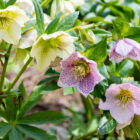
How and when to plant tulips
Planting tulips
Planting tulips is very simple, just follow small rules and precautions to ensure health and well-being to these beautiful bulb plants. Ideal for decorating balconies, terraces and gardens, tulips are much appreciated by garden enthusiasts. So, this article will cover all the fundamental aspects of tulip cultivation. In particular, the soil, when to plant tulips, and the necessary care to get beautiful blooms that last a long time.
Where to buy tulip bulbs
Tulips are among the most popular garden flowers as they are able to give spectacular blooms. Among the most famous and brightly coloured tulip varieties are the Dutch tulips whose beauty is famous all over the world. They are also very easy to care for.
It is possible to purchase tulip bulbs in any garden shop, nurseries and on the web. In particular, online you can find sites that both give information and offer valuable products. This way, you can create beautiful chromatic angles on your balcony or garden.
How to store tulip bulbs
It is preferable not to store tulip bulbs for a long time. As a matter of fact, you should plant them within a week of purchase. In fact, if you store them for too long without planting, the risk is to damage the bulb. Actually, in the Netherlands, the cold storage of bulbs happens in special cells at constant temperature, equipment that no one in their own home has available.
When to plant tulips
The right time to plant tulip bulbs is autumn, between October and November. During the autumn season and before winter frosts begin, you can plant not only Dutch tulips, but also daffodils and hyacinths.
Planting tulips and other bulbs
In the gardens or on the terraces it is possible to create spectacular corners, planting not only tulips but also other bulbs. Let’s find out more.
Flower bulbs to summer flowering
However, much of the variety of tulips adapts easily to environmental conditions. They may flower even when the planting takes place “out of season”, between the end of winter and the first half of spring. Planting in spring is possible but not later than March (in the south areas) and April (in the north areas). In the latter case, tulip bulbs might bloom in the summer. During this period, you can also plant calla and begonia, in order to have a beautiful flower garden in summer.
Begonia
 Begonia is one of the summer flowering bulbous species. Better known as Begonia tuberosa and has tropical origins. People mostly appreciate its ornamental and very abundant foliage, and its large flowers of various colors. It is advisable to start growing this bulbous from the end of March and early April. It is preferable to bury the tuber when the temperatures are higher than 16 °C.
Begonia is one of the summer flowering bulbous species. Better known as Begonia tuberosa and has tropical origins. People mostly appreciate its ornamental and very abundant foliage, and its large flowers of various colors. It is advisable to start growing this bulbous from the end of March and early April. It is preferable to bury the tuber when the temperatures are higher than 16 °C.
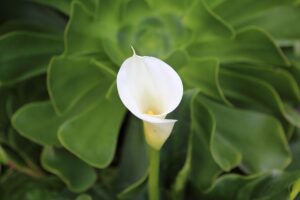 Calla
Calla
The Calla lily is characterised by a wide range of colours from white to dark purple tending to black. It is a bulbous plant that lends itself to beautifying not only gardens but also terraces and balconies. Calla lilies should be planted in spring when temperatures are around 16 °C and frost does not occur.
 Anemone Coronaria
Anemone Coronaria
Anemone Coronaria is a bulbous plant with jagged leaves. Its single or double flowers may be white, red, blue or tending to purple. It is a flower that blooms between May and August. Plant the Anemone Coronaria in a place with plenty of sun in the morning but also shelter during the hot afternoon hours.
 Agapanto
Agapanto
The Agapanthus is a South African plant, only arrived in the west countries at the end of the 18th century. Relative of the lily, it has an elegant and slender shape. It has beautiful flowers in various shades ranging from snow-white to light blue and lilac. It is advisable to plant Agapanthus in spring, when frost is only a distant memory.
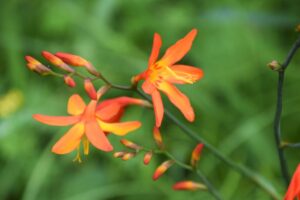 Crocosmia
Crocosmia
The Crocosmia is a perennial bulbous from the family of the Iridaceae, such as the Iris and the Gladiolus. The flowers of this plant are spectacular and give beautiful blooms during the summer. In fact, they look like small gladioli and give spectacular blooms throughout the summer. It is advisable to proceed with the planting of the Crocosmia from March onwards when there is no longer a risk of frost in the ground.
Bulbs, from flower to winter flowering
Towards the end of summer, however, it is possible to plant other bulbs, and consequently to plan a winter flowering. Among the winter flowering bulbous, there are amaryllis, chionodoxa, iris, and many others. Finally, if you decide to carry out this operation “out of time”, it is advisable to add fertiliser to the soil directly to the planting.
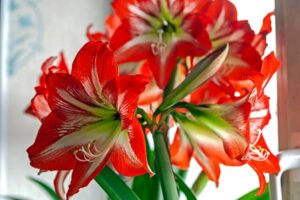 Amaryllis
Amaryllis
Winter flowering bulbs include the Amaryllis also known as Amaryllis belladonna. Its leaves are up to 50 cm long and the sturdy stems are 50-70 cm high. Amaryllis produces 6 to 10 flowers, trumpet-shaped and drooping. The colours vary from pink to red to white.
 Chionodoxa
Chionodoxa
Other species include Chionodoxa, which has blue flowers. It belongs to the perennial plants, which flower in winter. They are ideal for creating rocky garden corners. They can reach a height of 10-20 cm.
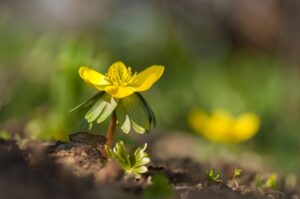 Eranthis
Eranthis
Eranthis, or winter aconite, has leathery, dark green and very shiny leaves. The stems are no longer than 10-15 cm. Its flowers are yellow and have a rounded shape similar to small balloons.
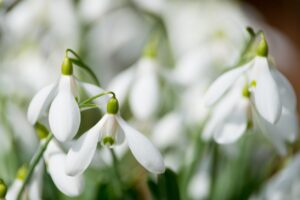 Snowdrops and other winter-flowering bulbs
Snowdrops and other winter-flowering bulbs
Very common is the Snowdrop, whose leaves are up to 20 cm long. The flowers have six white petals with longitudinal stripes. Other winter-blooming bulbous plants are the Muscari with clumps of thin, ribbon-like leaves. The flowers are deep blue and very small. Finally, there is the Scilla, or squills, whose stems are no taller than 20-30 cm. Their flowers are white, blue or pink.
What about planting tulips in winter?
It is possible to plant tulip bulbs even during the winter period. However, winter is a cold season which is critical for the soil. In this case, it is advisable to loosen the soil well and protect the surface with straw. Planting tulips is also preferable in pots at this time.
How to plant tulips
It is possible to plant tulips both in pots and in open fields. When planting tulips in pots, place it in a sunny spot, far from winds and draughts. In particular, the potting soil should be basic and not wet. It is advisable to create a thin layer of clay in order to give the soil greater draining capacity. Place the bulbs at a distance of at least 10 cm from each other. Very popular for growing in pots is the giant tulip of the Cottage variety. It is a bulb that flowers between March and April and can reach a height of around 80 cm. This variety can grow with other giant tulips. In particular, with those of the Darwin group and Darwing hybrids, which offer spectacular blooms.
Creating a flowerbed in the garden with tulips
Conversely, if you decide to plant bulbs in the garden or want to create a flower bed, you will need to correct the soil when planting. In particular, if the soil is clayey and compact, add river sand. If the soil is not fertile enough, enrich it with organic fertiliser. Before planting the bulbs, choose an area that receives enough sun. The planting depth should always be 3 times the diameter of the bulb. Plant the bulb with the tip pointing upwards, at a distance of approximately 10 – 12 cm between each tulip. The soil must never be damp, otherwise the bulbs may rot.
Planting tulips and other bulbous plants in layers
Adopt this technique especially if you do not have a garden, but want to create a small flowery corner. This type of layer cultivation can prolong the flowering time of all bulbous plants. Thus, for example, a single pot may contain bulbs of different varieties. The flowering may happen gradually for a period of up to 40 days.
How to proceed?
Firstly, it is necessary to obtain a fairly large pot with a bottom of at least 40 cm, with holes for draining excess water. Place a first layer of clay of 2-3 cm, useful for drainage. After that, put a layer of at least 5 cm of universal soil. This will form the base on which the bulbs of flowers of later flowering will grow. Cover them with another layer of soil of at least 5 cm and place the intermediate-flowering ones on top. Moreover, cover these bulbs with potting soil. Finally, place the early-blooming ones, for example snowdrops, and cover them with a layer of soil not exceeding 3 cm.
Universal fertiliser for plants and flowers – Doctor Bioges recommends Mister Plants Bio for planting tulip bulbs
Most people think that it is necessary to apply a pellet fertiliser directly into the hole when planting a tulip bulb. However, a fertiliser of this type could damage the new roots, which might burn. Instead, it is preferable to use, a liquid organic fertiliser and always administer it from the top of the soil.
In this case, the roots will filter the formulation better, which will prevent them from burning. Mister Plants Bio is a natural fertiliser of plant origin, rich in humified organic matter. The latter, in particular, improves its structure and its chemical-physical and biological properties. Mister Plants Bio does not stink, so it is also ideal for those who create a vegetable garden on their balcony or terrace.
How to grow tulips
Holland is known the world over for its expanses of tulips. These magnificent flowers, imported in the 16th century from the Middle East, quickly spread throughout the country. Initially, mainly yellow-flowered and red-flowered varieties were widespread. Among the most famous varieties in history is the Semper Augustus tulip, characterised by white flowers with red streaks. Today, the Semper Augustus tulip bulbs are extinct, making way for new, equally colourful varieties produced by crosses and selections. In particular, they are the subject of increasingly colourful and floriferous selections. Today, Holland is the world’s leading exporter of flowers, and tulips and their bulbs are among the most popular items! In fact, tulips are perfect for any occasion: e.g. a wedding or a birthday. In the following paragraphs you will learn more about how to grow tulips.
Planting tulips – where?
Tulips are bulbous plants that like to be in a sunny position. In fact, they can withstand direct sunlight very well. However, during hot summer days it is inadvisable to keep them in full sunlight. In fact, even if they are resistant, the leaves of the tulips could burn. Therefore, they should be sheltered from direct sunlight during that season. What the tulip does not like are areas that are too windy, or a corner of the house subject to a strong current. To sum up, the tulip is a bulb plant that loves warmth and sunny areas, as long as they are not too windy.
Watering tulips
Tulips generally require little care and attention. During the growth phase and during flowering these beautiful bulbs only like moderate humidity. In particular, if the bulbs are planted in the garden, it is advisable to water moderately only five days after planting. Thereafter, it is preferable to water only when there is not enough rain and the soil is very dry. Similarly for bulbs planted in pots, you should always water very sparingly and only increase the frequency during the summer months if temperatures are only high and the soil is very dry.
Flowering
Depending on the variety grown, tulips flower from late spring until early autumn. During the flowering period, the tulip plant should be fertilised. In fact, the flowering period is very delicate and it is necessary to intervene with the regular administration of a bulb fertiliser for about four weeks. This type of fertiliser can be purchased in any garden shop or online. In addition, for a constantly flowering garden, Doctor Bioges recommends growing tulip varieties with different flowering times.
Fertiliser for bulbous plants, which one? Doctor Bioges recommends Vivacity
Vivacity is a fertiliser that promotes long lasting flowering. It also gives flowers vibrant and intense colours. This liquid fertiliser can also be used for other bulb plants such as freesias, irises, calla lilies, begonias, cyclamens, narcissus, hyacinths, and many others. In addition, during flowering, Doctor Bioges recommends protecting plants from direct sunlight by using tarpaulins. This will preserve the brilliance of the colours and protect them from sun’s rays. Regular applications of fertiliser ensure visible results within a few days as well as giving the bulb all the energy it needs to flourish again year after year.
Pruning tulips after flowering
When the petals of the tulips begin to wither, the flower stems can be cut off at the base. This prevents the plant from investing its energy in seed production. While it is advisable to leave the leaves of the plant until they wither. In fact, during this slow wilting phase, the leaves continue to supply energy to the bulbs.
Tulip pests
Tulips can also be attacked by insects and pests such as millipedes, beetles, cockroaches, mites and slugs. This can be seen if the leaves have holes in them. To protect tulips, it is sufficient to use DIY traps. For example, a glass filled with beer can be buried and replaced every two to three days. In garden shops it is possible to buy insecticides or salt-covered tapes, which act as repellents. However, the latter must be removed when it rains as they are phytotoxic. Action must be taken in good time during the flowering period. Just do a small weekly check and make sure that everything is going well.
Diseases
The tulip can be attacked by Botrytis tulipae. This is a fungal disease that favours the occurrence of root rot. To avoid this disease, observe a sufficient distance between the bulbs while planting tulips. In addition, try to ventilate the soil mand avoid waterlogging at all costs.
Other fungal diseases that can attack tulip bulbs are Penicillium. This pathogen manifests itself in the form of a blue-coloured mould that develops under the outer cataphylls. Another pathogen is Phytophtora.
How to intervene?
It is possible to counteract and treat the first manifestations of such fungal diseases by using the sulphur-based Even Green biological formulation. This product also gives excellent results on various types of mould and fungal diseases. It promotes a rapid recovery of the plant from the disease by strengthening its endogenous defences. The formulation is organic and not a plant protection product.
Planting tulips: watch out for dogs and cats!
Tulips are potentially lethal bulbous plants for our four-legged friends. They contain a poisonous substance called ‘tulipanin’, which causes vomiting, convulsions and even poisoning in animals, particularly cats. In dogs, the ingestion of this substance can cause vomiting and diarrhoea.
In any case, one must always be very careful with this substance and plant tulips in areas not accessible to pets. In addition, one must prevent the animal from coming into contact with the water in the pot as it could be contaminated with this poisonous substance. In fact, tulipanin is also harmful to human health. In fact, it can cause irritation on our skin.

